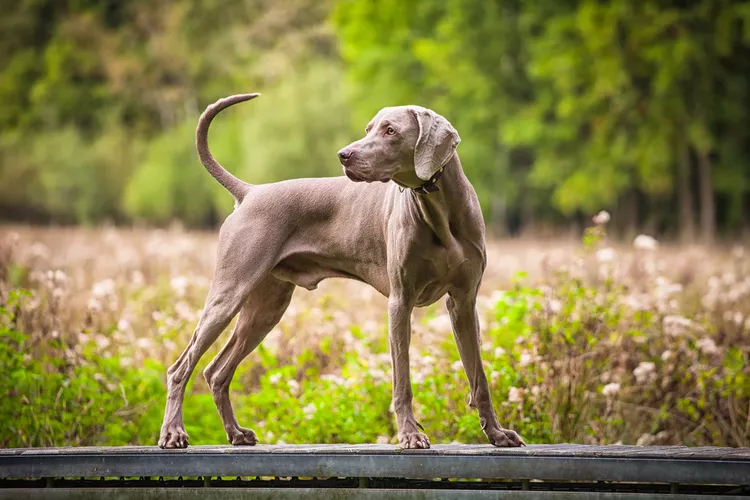Weimaraner Dog Breed Characteristics
The Weimaraner, known for its shiny silver-gray fur and captivating amber or blue eyes, is a distinguished breed with a history of versatility. They were first bred in Germany during the early 1800s for hunting big game, but now they are also cherished as loyal companions and family pets. As per Weimaraner dog breed information, these dogs are intelligent, obedient, and full of vitality, requiring active owners, preferably experienced breeders who can provide thorough and consistent training. Weimaraners, as per the Club of America, aren’t just pets; they become integral members of the household, embodying the heart of the family.
Yet, according to AKC, owning a Weimaraner isn’t as challenging as perceived, despite their intense temperament and need for regular exercise. When considering Weimaraner dog breed information and how to care for such an energetic and clever breed like Weim, it’s clear that understanding their needs from a certified breeder is critical to ensuring their happiness and health.
Key Takeaways
- Weimaraners originated in Germany for hunting.
- They need active owners for happiness and health.
- Training and exercise are crucial for this breed.
The Weimaraner, recognized by its silver-gray coat and striking eyes, originated in Germany as a versatile hunting dog, according to AKC’s Weimaraner dog breed information. Today, according to the popular dog community, they are greatly valued as energetic family members. These intelligent dogs thrive with active owners who can commit to consistent training and provide ample exercise. Prospective Weimaraner owners must understand the breed’s requirements to maintain their well-being.
Quick Facts
The Weimaraner stands out with its oversized build and athletic frame, with male dogs growing to 25-27 inches tall and females slightly shorter at 23-25 inches.
This breed was developed for hunting and had a strong instinct to chase, making daily exercise and mental stimulation essential for its happiness.
Belonging to the Sporting Group, Weimaraners have a lifespan of 10-13 years. Owners should be mindful of health conditions like bloat, skin allergies, and hip dysplasia that can affect this breed.
Often referred to as the ‘grey ghost’ because of its coat color, the Weimaraner is famous for those who lead an active lifestyle.
Weimaraner Dog Breed Pictures






Overview
The Weimaraner’s distinctive grace and agility originate from the breed’s history as a skilled hunting companion, necessitating rigorous exercise and intelligent engagement to prevent restlessness and behavioral issues. This German breed, recognized for its sleek gray coat, is notably large and athletic, demanding a robust exercise regimen and consistent mental stimulation to maintain its well-being.
Their strong prey drive, a remnant of their hunting heritage, may pose challenges in multi-pet households. Weimaraners benefit from regular grooming, including weekly brushing and thorough ear examinations to uphold their health and appearance.
Despite their robustness, they are susceptible to specific health conditions like bloat, hip dysplasia, and skin allergies, making proactive veterinary care a fundamental aspect of responsible Weimaraner ownership.
Weimaraners Hallmarks
Weimaraners are medium- to large-sized dogs known for their graceful silver coats and hunting skills. They are affectionately called the ‘grey ghost’ for their unique coat color and quiet hunting methods. These dogs combine elegance with athletic ability, making them stand out. They need plenty of exercise due to their high prey drive, and they love being around people, which means they do best when they can live close to their families.
| Trait | Description | Relevance |
|---|---|---|
| Coat Type | Smooth coat; there is also a long-haired type | Shedding is minor, but they’re not fond of cold |
| Athleticism | Suitable for different landscapes and swimming | Ideal for different terrains and swimming |
| Temperament | Sociable; have a strong instinct to hunt | Consistent training and social interaction are key |
Weimaraners’ physical and personality traits mean they need owners who understand how to train them properly and care for their health and daily needs.
To ensure a Weimaraner thrives, they require an informed owner about their training needs, health care, and daily interactions.
Puppy and Adult Weimaraner Breed Origins

The roots of the Weimaraner breed stretch back to Germany, where nobles carefully developed it as a skilled hunting dog. The species has been refined throughout history to combine strength with elegance, resulting in the distinctive qualities that define the Weimaraner today. Perfected over many years, these characteristics make the breed stand out in outdoor activities and as family pets.
- Ancestral Lineage Roots
- German nobles crafted the Weimaraner in the 1800s for its hunting skills.
- The breed was selected for its muscle, endurance, and keen sense of smell.
- It was interbred with Bloodhounds and other pointers to achieve the right features.
- Historical Development
- Weimaraners shifted from hunting big game to excelling in retrieving smaller animals.
- They gained popularity among hunters and dog lovers beyond Germany.
- Breed clubs were formed to set the standards for the Weimaraner’s physical and behavioral traits.
- Notable Traits Evolution
- The breed’s smooth, silver coat earned it the nickname ‘grey ghost.’
- Adaptations like tail docking and webbed feet help them in aquatic environments and hunting.
- They’ve been trained to balance their natural hunting instincts with being obedient companions.
In crafting the Weimaraner, German nobility in the 19th century were focused on creating a dog with hunting prowess. They aimed for a dog with robust strength, incredible stamina, and an exceptional sense of smell. Combining Weimaraners with Bloodhounds and other pointer breeds infused the desired characteristics into the lineage.
As time passed, Weimaraners transitioned from chasing large game to becoming versatile in retrieving smaller prey. This adaptability helped the breed cross the German borders, winning the hearts of hunters and dog lovers worldwide. Breed clubs played a pivotal role in standardizing the Weimaraner traits, ensuring the breed’s qualities were upheld.
The evolution of the Weimaraner’s notable traits is fascinating. Their sleek, grey coat is so distinctive it led to their nickname ‘grey ghost.’ Physical characteristics like tail docking and webbed feet are not just for show; they serve the practical purpose of aiding the dogs in swimming and hunting in water. Behaviorally, Weimaraners have been refined to have a strong prey drive while remaining trainable and good companions at home.
Ancestral Lineage Roots
Tracing back to the early 19th century in Germany, Weimaraner dogs were meticulously bred for the aristocracy to fulfill the need to hunt large game. At the Weimar court, their distinctive physical and behavioral traits were honed to create a versatile and reliable breed.
Initially used for tracking and hunting formidable quarries such as boar, bear, and deer, these dogs adapted to pursue more minor games, showcasing their versatility. Their unique silver-grey coat earned them the moniker ‘grey ghost,’ and their keen athleticism was selectively enhanced to meet the demands of noble hunting parties.
The breed’s lineage outside Germany was later expanded by enthusiasts like Howard Knight, who imported Weimaraners to the United States, solidifying their global presence.
Historical Development
Emerging from the opulent hunting traditions of German nobility in the early 1800s, Weimaraners were developed to exhibit both power and grace, serving as efficient hunters who could tackle a diverse range of game. First bred for their proficiency in hunting both large and small prey, the breed’s lineage is closely associated with the Grand Duke of Saxe-Weimar-Eisenach, Karl August, which is reflected in the breed’s name.
The Weimaraner’s striking appearance—characterized by its athletic build, docked tail, webbed paws, and captivating eye color—complements its hunting prowess. The Weimaraner Club, established to preserve the breed’s distinctive qualities, is intimately tied to the breed’s development.
Furthermore, the breed’s profile was elevated when President Dwight D. Eisenhower owned a Weimaraner, contributing to the breed’s popularity and historical significance.
Notable Traits Evolution
The Weimaraner is a dog breed developed in the 19th century to fulfill the needs of hunters. Their athletic build and distinctive silver-grey coat are the result of careful breeding. Hunters needed dogs that could chase both large and small game, so this breed’s natural hunting instincts were sharpened. The Weimaraner’s body is slim yet muscular, designed for bursts of speed and endurance.
Their coat is not only beautiful but also practical, requiring minimal grooming. However, Weimaraners need protection from the cold due to their thin jacket. Their attentive and intelligent expression reflects their ability to focus on tasks, making them excellent companions in various hunting scenarios. These characteristics make the Weimaraner a well-rounded hunter’s ally.
Physical Dimensions

The Weimaraner is a dog breed known for its well-proportioned physique, which lends to its agility and impressive appearance. When choosing or raising a Weimaraner, it’s vital to know that males and females differ in size. This difference is significant for those breeding or keeping these dogs. These dogs are built for both stamina and speed, a nod to their past as hunting dogs.
- Height and Weight Standards
- Males typically stand 24 to 27 inches tall
- For Females: usually measure 22 to 25 inches in height
- Insights into Weight
- Males weigh between 55 to 90 pounds
- Females tip the scales at 50 to 75 pounds
- Physical Composition
- Their bodies are muscular with an athletic look
- They move gracefully due to their symmetrical physique
- Their coat’s texture and color are practical, aiding in swift movement
Weimaraners have a distinct build that sets them apart. They possess a muscular frame that supports their active lifestyle. Their elegant gait is a result of their balanced body structure. The coat of a Weimaraner isn’t just for show; it helps them move efficiently, which is perfect for a dog that was bred for hunting.
Average Height Range
Weimaraners stand out with their impressive stature, usually hitting 23-27 inches for males and 22-25 inches for females. Known for their grace and athletic abilities, these large dogs make a strong impression. Males often weigh between 55 and 70 pounds, while females are a bit lighter at 50 to 65 pounds, aligning with their robust and active nature.
The size of a Weimaraner isn’t just for looks; it’s a nod to their history as diligent working dogs. Their larger frames give them the stamina needed for consistent, energetic exercise. This might include long walks or runs, which they require to stay healthy and happy. Their height adds to their striking look, with long ears framing their noble faces.
Body Weight Insights
For a healthy Weimaraner, weight is critical. Male Weimaraners should weigh between 55 and 90 pounds, and females should aim for 50 to 75 pounds. Their weight significantly affects their overall health and ability to stay active. It’s essential to monitor and manage their weight carefully.
Regular exercise is a must for these dogs. It helps keep them fit and sharpens their mind. A proper diet for your Weimaraner’s activity level and health is just as important. Working with a vet to create a diet and exercise plan helps maintain a healthy weight.
This can lead to a longer life span, typically 10-13 years, and improve their overall well-being.
Build and Structure
Weimaraners stand between 23 and 27 inches at the shoulder, showcasing a muscular, athletic frame reflecting their origins as skilled hunting companions. They weigh between 55 and 90 pounds and have a powerful and graceful body. Generally, males are more significant than females.
This dog, belonging to the sporting group, is known for its short and hard coat, which comes in shades from mouse-gray to silver-gray. A variant with a longer coat also exists, and it is just as elegant, with a softer texture to its fur.
These dogs have webbed feet that make them excellent swimmers, suitable for working in water. It’s essential to keep an eye on their health since they can suffer from issues like bloat, skin allergies, and hip dysplasia. These conditions can affect their activity levels and quality of life.
A Weimaraner’s lifespan typically reaches around ten years or more with proper care.
Gender Size Disparity
Weimaraners exhibit a clear difference in size between males and females. Male Weimaraners are typically larger, standing 25-27 inches tall and weighing 70-90 pounds. On the other hand, female Weimaraners are generally 23-25 inches in height and weigh 55-75 pounds.
This size difference affects how owners should care for and manage these dogs. For example, males might need different exercise plans to prevent joint problems due to greater weight. Understanding these size differences helps owners provide the proper care, which is vital for the dogs’ health and longevity.
Growth Stage Measurements
Monitoring the development of Weimaraner puppies is vital since these dogs go through distinct growth stages from their early days to full maturity. Initially, these puppies have quick growth periods that need close attention to ensure their bones and joints form correctly. Weimaraners are prone to hip dysplasia, a hereditary issue that can worsen with wrong growth patterns or too much activity, so balancing their diet and exercise is necessary. Regular vet visits can catch any early warning signs of this condition.
Males typically grow to 25-27 inches tall and weigh about 70-90 pounds, while females are usually smaller, standing at 23-25 inches and weighing 55-75 pounds when fully grown.
Temperament and Behavioral Traits

Weimaraners are known for their complex personalities and breed-specific traits. They combine high energy, smartness, and a strong hunting instinct, requiring careful training and socialization. It’s essential to grasp their unique temperament, needs for vigorous exercise, and tendency to develop anxiety when lonely for too long.
Temperament
These dogs are spirited and often show a desire for independence. Without a confident leader, they might try to dominate. They are also sensitive and respond best to gentle yet firm training methods.
Prey Drive
Their hunting heritage shows in their love for chasing things. If not trained well, this can cause them to ignore commands. To prevent this, it’s crucial to teach them to come when called, especially during off-leash play in safe areas.
Training and Socialization
Proper training is critical to managing their tendency to bark and be wary of strangers. Start this process early and use positive reinforcement to shape a friendly and obedient dog. This helps prevent unwanted behaviors and ensures they grow into well-rounded companions.
Temperamental Nature
Weimaraners are known for their high energy and need for exercise. They have an instinct to hunt and require consistent training to control their prey drive. These dogs need a lot of physical and mental activity to prevent destructive behaviors like destruction or hyperactivity. They can’t handle being inactive or alone for long periods.
Weimaraners are very social and can develop separation anxiety if left alone too much. They might act out if they’re not with their family. They need an owner to train them regularly and include them in family activities. If prepared with patience and positive feedback, these dogs follow commands well.
Prey Drive Instincts
Weimaraners have a strong prey drive due to their history as hunting dogs. This means owners must work hard to train and socialize them to live peacefully with other pets.
These dogs have a lot of energy and tend to chase smaller animals, which can be problematic in a home with different kinds of pets. Owners should ensure their Weimaraners get plenty of exercise and mental challenges to help control their hunting instincts.
Managing their prey drive is crucial to prevent attacks on other animals and to keep the home environment calm and safe for everyone.
Training & Socialization
Training Weimaraners early on is critical due to their strong hunting instincts. Consistent guidance helps prevent unwanted habits and helps them become friendly pets. These dogs are energetic and need regular exercise, mental stimulation, and ongoing training to keep them well-behaved. Using rewards and praise works best to teach them good behavior.
Weimaraners love being around people, so it’s critical to be assertive and patient when training them to be calm and obedient. Because they like to chase, it’s essential to introduce them to other animals early on to reduce any potential for conflict. This helps them learn to live peacefully with other pets at home.
Guiding their sharp minds with rewarding methods and steady instruction allows Weimaraners to integrate seamlessly into family life.
Exercise Requirements
Weimaraners need plenty of exercise to stay happy and healthy. They require physical and mental stimulation to keep them from getting bored and acting out. These active dogs thrive on running, agility courses, and dog sports, which keep them fit and use up their energy.
Training sessions are also vital, challenging their brilliant brains and preventing restlessness. If Weimaraners don’t get enough activity, they can become challenging to manage. Owners should provide a mix of workouts and brain games to keep these dogs well-rounded and peaceful.
Separation Anxiety Risk
Weimaraners form a solid attachment to their owners, making them prone to separation anxiety. This condition can lead to destructive behavior and loud barking when they’re alone. These dogs crave constant human company, often becoming anxious and unable to relax if left alone.
Early socialization and crate training are vital to prevent a Weimaraner puppy from trying to escape when alone. To help these dogs handle being alone, they need proper training and activities that keep their minds busy. Interactive toys and seeking help from a dog behaviorist can be vital to managing their anxiety and stopping bad habits from developing.
Best Dog Wellness Considerations

Weimaraners need a well-rounded wellness strategy that includes regular health checks, specialized nutrition, and plenty of exercise. Conducting health screenings is essential as it helps catch and manage diseases common in Weimaraners early on. Adequate nutrition and exercise are necessary for these energetic dogs to stay healthy and happy.
Health Checks
Early genetic screening is vital for detecting hip dysplasia and von Willebrand’s disease. Frequent health exams are necessary to look for bloat or gastric torsion, which can be life-threatening for Weimaraners. According to the American Kennel Club, it’s also essential to check their hearts regularly to stay in top shape.
Nutritional Needs
Weimaraners thrive on a diet that’s high in quality protein to match their muscular build. Their calorie intake should be carefully monitored to prevent weight gain, considering their age, size, and how active they are. Their diet should also include omega fatty acids, vitamins, and minerals to support their immune system and maintain a shiny coat.
Exercise Requirements
A Weimaraner’s need for daily, vigorous exercise is non-negotiable to keep their energy levels in check and prevent bad behavior. Providing mental stimulation through training and interactive toys can help ease their separation anxiety. Activities like tracking or agility training fulfill their instincts and keep their minds sharp.
Health Screening Importance
Regular health check-ups are essential for the well-being of Weimaraners. These examinations are vital in detecting and treating health problems early on, especially those familiar to the breed. Owners should be alert for symptoms of bloat, skin allergies, and hip dysplasia. Early detection allows for timely intervention, improving the success of managing these issues.
Responsible Weimaraner ownership includes prioritizing these health checks. Doing so helps tailor health care plans that fit their needs, focusing on diet and exercise. This approach ensures that Weimaraners stay healthy, active, and happy companions.
Nutritional Requirements
A nutritious diet is vital to keeping a Weimaraner energetic and healthy. These dogs have a history of hunting, so they need food that supports their muscular body and active life.
They need plenty of protein to keep their muscles in good shape. To prevent bloat, a serious health issue for Weimaraners, giving them small meals throughout the day instead of one big meal is better.
Adding omega-3 fatty acids to their diet can improve skin and coat condition. It’s also essential to adjust their food based on their age, how much they exercise, and any specific health concerns to keep them thriving.
Exercise and Activity Needs
Weimaraners are high-energy dogs that need plenty of exercise every day to stay healthy and happy. A big yard where they can run and play is ideal for this active breed.
Their athleticism makes them perfect for dog sports, which keeps them fit and strengthens the bond between dog and owner. These dogs come from a hunting background, so consistent and patient training is critical to managing their strong instincts.
Regular physical activity is critical for preventing bloat and hip dysplasia and keeping the dog healthy.
Essential Maintenance Practices
Maintaining a Weimaraner’s well-being involves a combination of care strategies. Ensuring their coat, diet, and well-managed physical activity helps prevent breed-specific health issues and supports their happiness. Consistent training and routine vet check-ups are vital for these bright and energetic canines to enjoy a harmonious life.
Grooming is critical, with a weekly brushing routine to reduce shedding. Regular examinations and maintenance of their paws and nails are necessary. Cleaning their ears is essential to ward off infections.
Regarding nutrition, feeding them two or three smaller meals can help prevent bloat. Selecting a premium food that suits their high energy needs is essential. It’s also crucial to monitor their weight to avoid obesity-related problems.
As for exercise, daily physical activities like walks, runs, or playtime are essential. Weimaraners also benefit from brain games that tap into their natural hunting instincts. When exercising off-leash, ensure the area is secure to prevent them from escaping.
Grooming Routine Essentials
To keep a Weimaraner looking its best, brushing, ear cleaning, and nail trimming are vital. Their distinctive coat, ranging from mouse-gray to silver-gray, shines more with a weekly brush that removes loose hairs and spreads the skin’s oils.
It’s good to frequently check and clean their ears to stop any infections, especially since their light amber eyes can show if they’re in pain or discomfort.
Trimming their nails is not just about looking neat; it also avoids painful overgrowth that can mess with their walking. Weimaraners are intelligent and can be trained easily, so they often get used to and even like these grooming tasks if you do them regularly and reward them for being good.
Nutrition and Diet
Feeding your Weimaraner a diet that meets its specific needs is essential to keep them energetic and healthy. These dogs, known for their athletic build, require diets rich in high-quality protein to help with muscle upkeep and repair. They also need enough carbohydrates to support their high activity levels and fats that are good for their health, contributing to a shiny coat and good brain function. It’s wise to work with a vet to tailor your dog’s diet, especially if they have food sensitivities or allergies.
It’s best to split their food intake into two meals daily to prevent severe issues like bloat, which can be fatal. Keeping an eye on your dog’s weight is also important to adjust their food intake if needed, helping to avoid obesity and related health problems.
Exercise Requirements
Weimaraners are a high-energy dog breed that thrive when given plenty of exercise. They have a natural athleticism and need significant physical activity to stay physically and mentally healthy.
For these dogs, daily exercise routines like running, playing games that involve interaction, and taking long walks are essential. This helps them burn off energy and stay fit.
A spacious, secure yard or open area allows Weimaraners to run and play safely. This will enable them to use their energy in a controlled setting.
Engaging their minds is as important as physical activity to prevent boredom and discourage destructive habits. Using interactive toys and puzzles can keep their minds sharp.
Consistent training is crucial in managing their energy and promoting good behavior, balancing activity and mental focus.
Health Check Schedules
Regular vet check-ups are crucial for the health and well-being of Weimaraners. These visits help catch any issues early, essential for a breed known for strength and stamina.
Keeping their teeth clean through daily brushing and visits to the vet prevents gum disease, which is common in these dogs. It’s also vital to protect them from parasites like fleas, ticks, and heartworms with ongoing treatments.
Good grooming keeps their coat and skin in top shape, so brush them regularly and bathe them when necessary. And don’t forget that their balanced, age-appropriate diet is vital to keeping your Weimaraner healthy and active.
Behavioral Training Tips
Ensuring the health and happiness of a Weimaraner is not just about regular vet visits and a balanced diet but also about giving them the proper behavioral training.
These dogs are known for thinking independently, which means they need a unique approach to training to pick up commands and act the way you want them to. You must show you’re the boss from the start to make them listen and respect you. Using rewards and praise works best with Weimaraners, making them more eager to learn.
It’s essential to be patient and keep trying, even when they get a little headstrong. Keep the training sessions well-organized but mix things up to keep them from getting bored and interested in learning. This helps reinforce the behavior you’re looking for.
Nutritional Requirements
A Weimaraner’s diet must sustain their energetic lifestyle and strong muscles. It’s crucial to have a structured feeding routine and to monitor meal sizes to avoid obesity and meet the dog’s nutritional requirements. Following prescribed dietary plans helps prevent adverse reactions to food allergies.
Essentials for a Healthy Diet
For tissue repair and muscle upkeep, high-grade proteins are vital. To maintain a shiny coat and supple skin, omega-3 and omega-6 fatty acids are necessary. Carbohydrates are also essential to keep the dog energized all day.
Advice on Feeding
Adjust calories based on the dog’s age, size, and activity. Regular feeding times aid in metabolic and digestive health. Correct meal portions are essential for weight management and to prevent overeating.
Dealing with Food Allergies
Be vigilant in identifying and steering clear of allergens. Introduce hypoallergenic options for dogs with sensitivities. Watch for any signs of digestive issues or allergic reactions.
Essential Dietary Needs
Understanding the nutritional needs of Weimaraners is vital for their well-being. These dogs thrive on a diet of protein, carbohydrates, fats, vitamins, and minerals. They need to eat according to their life stage, body size, and how active they are. Portion sizes should be watched to prevent obesity and related health issues.
A vet should always be consulted to create the best meal plan for Weimaraners, especially if they have specific dietary needs or allergies. It’s also essential for these dogs to have plenty of water, especially after exercise. Keeping an eye on their weight and body condition helps ensure their diet works for them and allows for necessary changes.
Feeding Schedule Tips
A regular feeding schedule is critical to keeping a Weimaraner healthy and energetic. It can help prevent common health problems like bloat. These dogs were bred for hunting and needed a diet that fit their active way of life.
Choosing high-quality dog food that meets their nutritional needs is critical. A good rule of thumb is to feed them 2-3 smaller meals throughout the day instead of one big one to lower the risk of bloat.
Talking to a vet will help you determine the best amount of food and how often to feed your Weimaraner. This will depend on their age, size, and how active they are.
It’s also important to pay attention to how your dog reacts to their food since some dogs have food sensitivities or allergies. Any changes to their diet or how often they eat should be made carefully to keep them in top health.
Common Food Allergies
Recognizing common food allergens in dogs, such as beef, dairy, wheat, and chicken, is vital for preventing adverse allergic reactions in a Weimaraner. These ingredients may cause sensitivities in the breed, leading to skin rashes, itching, digestive issues, and ear infections.
Dog owners need to watch for allergy signs and get professional advice from a vet. Choosing dog foods designed for sensitive pets, which avoid known allergens and use limited or unusual protein sources, helps reduce allergy risks.
When guided by a vet, a varied diet or home-cooked meals can provide a balanced and safe diet for a Weimaraner’s health.

